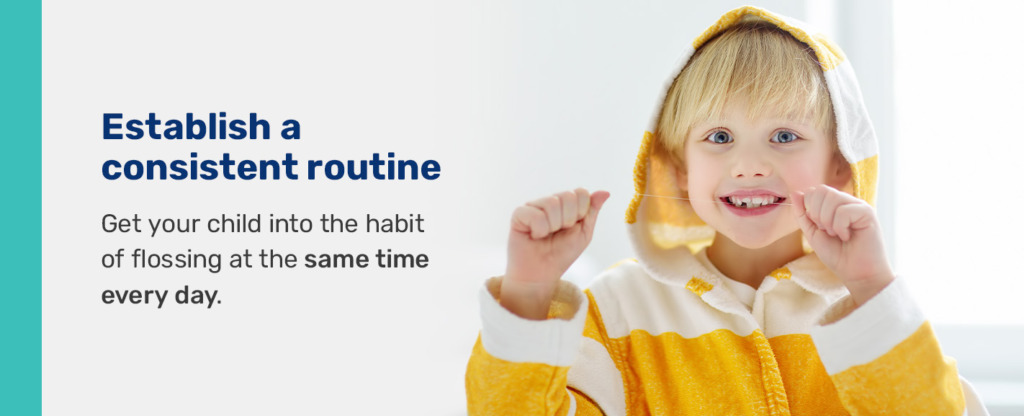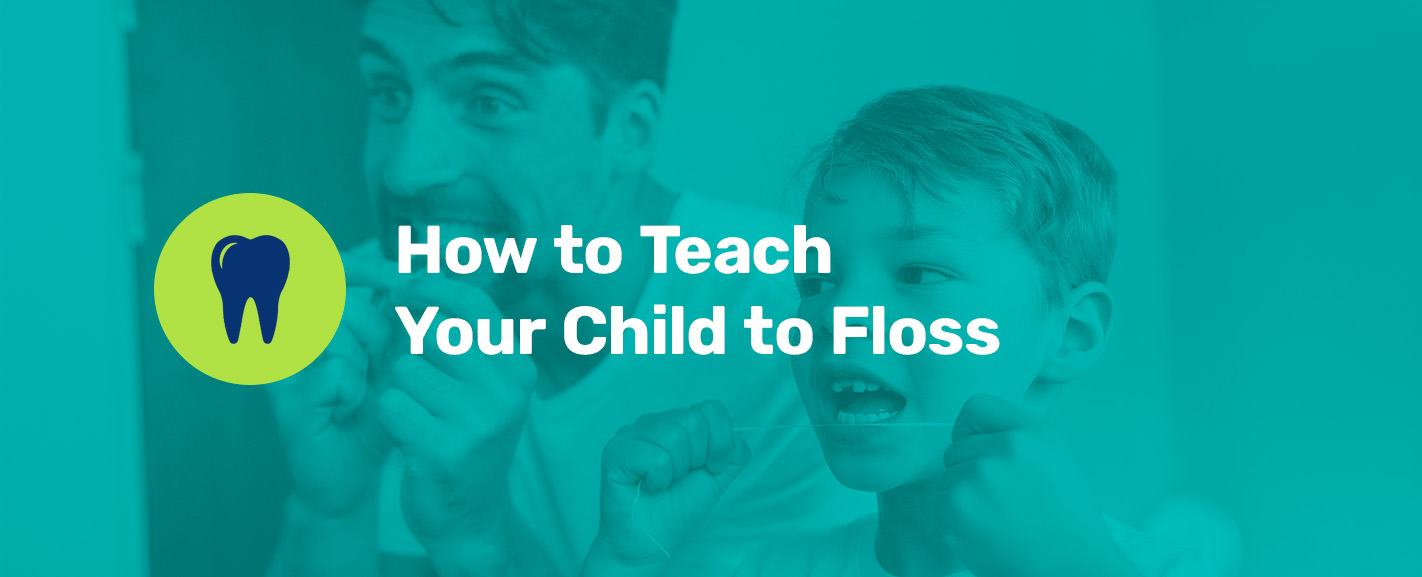As a parent, you love seeing a smile on your child’s face. If you want your child’s smile to last a lifetime, the secret is getting them into the habit of flossing from a young age. Do you want to know how to teach your child to floss their teeth? From correct flossing techniques to games to teach kids to floss, this guide will teach you everything you need to know!
- The Importance of Flossing
- Flossing Techniques
- Flossing Games and Making Flossing Fun
- How Do You Make Flossing Fun for Kids?
- Creative Ways to Encourage Flossing
- Common Flossing Mistakes and How to Avoid Them
The Importance of Flossing
We know the value of brushing our teeth, but there are some places that toothbrush bristles can’t reach. That’s where dental floss comes in!
Why Flossing Is Essential for Oral Health
Here are some of the benefits of regular flossing:
- Prevents cavities and gum disease: Floss removes food and plaque between teeth. Removing plaque before it hardens helps prevent tooth decay and gum disease.
- Complements brushing: Flossing works together with brushing to clean teeth thoroughly. Toothbrushes clean the surface of the teeth, while floss tackles the spaces between teeth. Flossing also removes more bacteria that cause bad breath than brushing alone.
At What Age Should a Child Start Flossing?
Introducing your child to flossing at a young age will help them form a healthy habit that will last a lifetime!
- Recommended age to start flossing: Parents can begin flossing their children’s teeth when they have two teeth that touch.
- Age your child can floss by themselves: Between 8 and 10 years old, your child should be ready to take over flossing duties. At this age, their hands can hold the floss.
Flossing Techniques
Whether you’re teaching your kid to floss or could use some tips yourself, here is a go-to guide for flossing like a pro!
Step-by-Step Guide to Flossing
Follow these steps to teach your child how to floss their teeth:
- Step 1: Break off a 15- to 18-inch piece of floss. Wrap each end around the middle fingers of each hand.
- Step 2: Hold the floss between your thumb and index finger.
- Step 3: Use a gentle rubbing motion to move the floss between each tooth.
- Step 4: Curve the floss into a C-shape against one tooth and slide it between the tooth and gum.
- Step 5: Move the floss up and down against the side of the tooth.
- Step 6: Repeat steps 1 to 5 on all teeth, including the back side of the teeth at the back of your mouth.
Different Types of Floss and Flossing Tools
Floss comes in more than just the string-like variety. There are three types of flossing tools:
- Traditional floss: A soft thread made from nylon or a similar material. Conventional dental floss is either waxed or unwaxed. Waxed floss tends not to fray and may slide more easily between the teeth. Floss also comes in various colors and flavors, making it more fun for younger flossers.
- Floss picks: This plastic tool has a short length of floss at one end and a plastic toothpick on the other. The handle makes it easier to maneuver the floss between the teeth.
- Water flossers: A device that uses a stream of water to rinse away food particles between teeth. It can also prevent plaque and bacteria buildup. Water flossers benefit those who wear braces or other orthodontic devices.
Flossing Games and Making Flossing Fun
Would you like to know how to encourage your child to floss? There are plenty of ways to turn floss time into FUN time!
How Do You Make Flossing Fun for Kids?
Here are some ideas for activities and games to teach kids to floss:
- Play-Doh floss game: Use egg cartons, ice trays or Lego blocks as “teeth”. Stick Play-Doh into the spaces between the teeth. Get your child to remove the Play-Doh using floss.
- Fight the “bad guys”: Turn flossing into a game of make-believe! The cavities are the villains and your kids are the heroes fighting with the power of floss!
- Let them choose: Children’s floss comes in various fun colors, flavors and packaging. If your child is old enough, let them choose the floss.
Creative Ways to Encourage Flossing
Are you looking for more creative ways to encourage your child to floss?
- Songs to teach kids to floss: Music makes everything more fun! Create lyrics to the tune of your child’s favorite song or nursery rhyme. There are many great songs about dental health on YouTube, like this one from CoComelon.
- Stories about flossing: Does your child love stories? Books like “Floss Your Teeth” by Katie Marisco or “A Tooth Story” by Dr Yosef Zayrof could be just what the dentist ordered! If you’re something of a storyteller yourself, come up with your own.
- Flossing charts and reward systems: Kids love visually seeing their progress. Create a colorful chart and stick it up in the bathroom. Each time your child flosses, they get a sticker on the chart. When they have a certain number of stickers, reward your child with something small and meaningful. A reward system motivates them to keep going and gives them a sense of achievement.
Common Flossing Mistakes and How to Avoid Them
The biggest flossing mistake is not flossing at all! Here are three other flossing errors to avoid:
- Flossing aggressively: Caution your child against flossing too hard. It can be painful and might push food further in.
- Skipping teeth: The teeth at the back of the mouth can be particularly tricky. Get your child to floss every tooth, including the hard-to-reach back teeth.
- Reusing floss: Teach your child to throw away used floss. Reusing the same floss moves food and plaque back between the teeth.
Tips for Effective Flossing

Use these simple tips to improve your child’s flossing routine:
- Easy does it: Use gentle pressure to floss your toddler’s teeth. For an older child, demonstrate how to floss gently to prevent gum damage. Pay special attention to the sensitive gumline.
- Establish a consistent routine: Get your child into the habit of flossing at the same time every day. Choose a time of day that works best for you and your child. Practicing regular flossing will make it second nature.
Early Education and Positive Reinforcement
Establishing good dental habits early in life is more likely to stick. A flossing routine adopted in childhood ensures the healthy development of your child’s teeth.
The best way to teach your kid to floss is to show them the proper flossing technique. Let them watch you floss, then explain to them what you are doing and why you are doing it that way.
Once you have shown your child how to floss, practice together. Stand in front of the mirror and have your child copy your actions. Guide and encourage them through the process. The key is to be patient and to celebrate their progress!
What Are Some Positive Reinforcement Techniques?
Try these techniques to encourage your child to floss:
- Offer praise and rewards: Celebrate when your child flosses. Tell them they’re doing a great job contributing to their oral health. Incentives and small rewards can keep them motivated.
- Compliment their oral hygiene: Tell your child how shiny and clean their teeth are. Compliment them on their beautiful smile. Make them feel good about flossing!
- Join in on flossing: Get the whole family involved in flossing time. Sharing this activity can make your child feel part of a team.
Trust Portland’s Pediatric Dental Specialists
As parents themselves, Dr. Dana Fox and Dr. Paul Fox understand the unique dental needs of children. Sprout Pediatric Dentistry & Orthodontics offers high-quality care in a comfortable environment. We believe education and prevention are the keys to oral health!
If you’re looking for a pediatric dentist you can trust in Portland, OR, visit Sprout Pediatric Dentistry & Orthodontics. Contact us to book your baby’s first dental appointment or to learn more about our pediatric dental services.


Dr. Dana grew up in Portland and went to Temple University in Philadelphia, PA for dental school. She then moved to Anchorage, AK for her residency in Pediatric Dentistry. Dr. Dana takes a holistic approach to pediatric dentistry & is able to use her own parenting experience to sympathize and understand each family’s unique dynamic.




